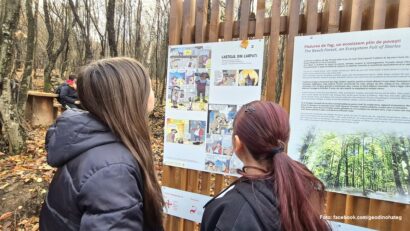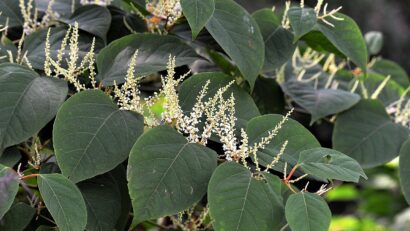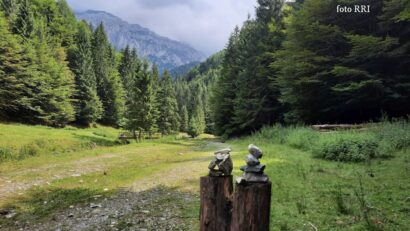Actions to combat desertification
A number of European states, including Romania, are confronted with desertification.

Ștefan Baciu, 26.06.2020, 14:00
World
Day to Combat Desertification and Drought was observed on 17th June,
an opportunity to remind people that pollution, climate change and extreme phenomena
will, in time, lead to the destruction of forests and crops and the degradation
and desertification of soil. A number of European states, including Romania,
are already confronted with desertification. In Romania, the phenomenon is
affecting the southern part of the country, near River Danube, as well as the
region of Dobruja. In the absence of measures to tackle the problem the
degraded surface areas are expanding from one year to the next, with sand taking
over more and more fertile land. A 2018 report of the European Court of Auditors
noted the lack of a common vision across the European Union and the fact that
the risk of desertification is not tackled efficiently and effectively.
In an interview to Radio Romania, the environment
minister Costel Alexe says the current government is willing to support the
implementation, as soon as possible, of projects to combat desertification and
mentioned a number of measures taken for the stabilisation of sand soil.
One
concrete example is the acacia forest that has been planted in Mârşani, in Dolj
county, for stabilisation and in order to prevent the expansion of sand dunes. The
Romanian government has at its disposal the financial resources to carry out
these campaigns and forestations on sand land, resources covered by the
amelioration fund and the Environment Fund Administration. The local authorities
need only identify the land in question and, especially, talk to the owners and
make them understand that unless we act very quickly, and we’re late as it is, it
will be far too late in ten- or twenty-years’ time.
Dolj
county, in the south of Romania, has the largest surface area of sandy soil in
Romania, namely more than 100,000 hectares, an area known as the Sahara of Romania.
The desertification process in Oltenia, a region in the southern part of the
country, is closely followed by the experts from the Research and Development Centre
for Plants Grown on Sand in Dăbuleni, who have proposed a number of solutions since
this institute was created. The centre’s director Aurelia Nedelcu believes the efficient
exploitation of this type of soil is the solution to combat desertification:
Sand
can be an ideal soil for agriculture, especially horticulture, considering the
average temperatures recorded in this climate in Oltenia, which is arid and
semi-arid. The amount of precipitation that falls in a year is not enough for
any species. This is why we must use irrigation. The soil in this area is sandy,
light, the result of wind activity and is easily moved by the wind, which is a
very restrictive factor in agriculture.
Fifty
years ago, an irrigation system known as the Sadova-Corabia system was built in
this area. Over 9,000 hectares of land were deforested, but another 1,400 hectares
of shelterbelts were created to prevent the advance of sand. Unfortunately,
some of these forests have disappeared in the last thirty years as a result of illegal
logging. The director of the Research and Development Centre for Plants Grown
on Sand in Dăbuleni Aurelia Nedelcu explains how sandy soils can be stabilised:
Rows
of 10-metre wide acacia shelterbelts are planted on sandy soils susceptible to
wind activity and dissipation. They are placed within a distance of 288 metres in
the most exposed areas and within 560 metres in the less vulnerable areas. The
effect of the wind is thus counteracted by these barriers made up of acacia
trees and shrubs. Rye is cultivated in autumn in strips located 50 metres of
each other, and in spring we cultivate horticultural plants to act as
windbreaks. Irrigation has also helped turn these sandy soils into land that
can be used in agriculture.
The Research
and Development Centre for Plants Grown on Sand in Dăbuleni has been studying
for many years how different plants and fruit trees adapt to sandy soils and
the results have been encouraging. The director of the centre Aurelia Nedelcu
tells us more:
Fruit
tree plantations were introduced, especially stone fruit trees such as peaches,
apricots and cherries. They responded well to irrigation. Vegetables were also
grown. The Dăbuleni water melons are now in high demand at farmers’ markets. While
in the past there was no question of growing potatoes here, this arid region
has been transformed, thanks to irrigation, into an area that produces early crops
of potatoes, a very profitable business for local farmers. Strawberries are
also doing very well here, and they can be harvested beginning in April.
Last
year, the Research and Development Centre for Plants Grown on Sand in Dăbuleni started
growing species that could so far only be found in Romania in botanical gardens,
such as kiwi, olive trees, Chinese dates, goji trees and fig trees. However,
creating new varieties and hybrids is not enough, but must be accompanied by
the most important means of combating desertification, namely irrigation.






























